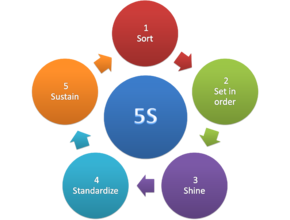In industry, total productive maintenance (TPM) is a system of maintaining and improving the integrity of production and quality systems through the machines, equipment, processes, and employees that add business value to an organisation.
TPM focuses on keeping all equipment in top working condition to avoid breakdowns and delays in manufacturing processes.
The eight pillars of TPM are mostly focused on proactive and preventive techniques for improving equipment reliability:

5S is a workplace organization method that uses a list of five Japanese words: seiri, seiton, seiso, seiketsu, and shitsuke. These have been translated as "Sort", "Set In Order", "Shine", "Standardize" and "Sustain". The list describes how to organize a work space for efficiency and effectiveness by identifying and storing the items used, maintaining the area and items, and sustaining the new order. The decision-making process usually comes from a dialogue about standardization, which builds understanding among employees of how they should do the work.
In some quarters, 5S has become 6S, the sixth element being safety
Other than a specific stand-alone methodology, 5S is frequently viewed as an element of a broader construct known as visual control, visual workplace, or visual factory. Under those (and similar) terminologies, Western companies were applying underlying concepts of 5S before publication, in English, of the formal 5S methodology.
